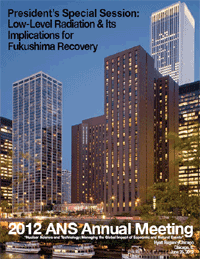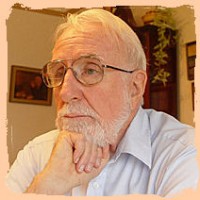Low level radiation and LNT examined at Chicago ANS meeting
 At the ANS Annual Meeting in Chicago held June 24-28, I attended the "President's Special Session on Low Level Radiation and Its Implications for Fukushima Recovery," and also the follow-on panel "Health Effects of Low-Level Radiation." The two sessions together could well have been subtitled "The Tragedy of LNT." In case you've forgotten, LNT stands for "Linear No Threshold"-the popular misconception that radiation risk is proportional to dose all the way down to zero.
At the ANS Annual Meeting in Chicago held June 24-28, I attended the "President's Special Session on Low Level Radiation and Its Implications for Fukushima Recovery," and also the follow-on panel "Health Effects of Low-Level Radiation." The two sessions together could well have been subtitled "The Tragedy of LNT." In case you've forgotten, LNT stands for "Linear No Threshold"-the popular misconception that radiation risk is proportional to dose all the way down to zero.
(Note: The units of radiation exposure are confusing even to professionals in the field. In this discussion, I will assume that all the radiation is low-LET, so that 1 cSv = 1 cGy = 1 rad = 1 rem. If you don't already know what LET means, you don't need to. For orientation, the average American gets about 0.3 cGy every year, background plus medical exposure. Some people in other countries get a lot more.)
The roster of speakers at the two sessions was impressive, and they seemed unanimous in the belief that basing policy and regulations on LNT has no empirical justification, and moreover has turned out to be a very costly blunder. They backed up their conclusions with data from a gamut of disciplines. Below is a brief synopsis. Some of the speakers participated in both sessions; in those cases I have lumped the two together.
Kazuaki Matsui, BSc, MSc[1] observed that the earthquake and tsunami on March 11, 2011, left 25,000 dead, injured, or missing. In contrast, there was "probably minimal or no health effect" from radiation from the damaged reactors at Fukushima. However, the ensuing evacuation disrupted more than 150,000 lives and has led to 13 suicides, along with 50 deaths of elderly evacuees [actually, 50 deaths seems to be a serious underestimate, since at least one Japanese newspaper is reporting 573 stress-related deaths]. The prevalent widespread radiophobia has led to grotesque overreactions.
Kiyohiko Sakamoto, MD, PhD [2], discussed his work both with cancerous mice and with ~200 human cancer patients, reporting impressive rates of cure and metastasis-prevention using various combinations of low-dose-rate, whole-body or half-body radiation-say 150 cGy (rem) spread over 5 weeks-and high-dose shots directed at the tumor. He concluded, among other things, that
- Low doses of radiation stimulate immunity to cancer and biological defences against DNA damage.
- The dose or dose rate at which radiation starts to become harmful is known.
- There is no basis to fear low level radiation. "Based on my experience in treating many patients," he says, "the radiation level near Fukushima is not a cancer risk."
Ron Mitchell, PhD [3] after examining data from A-bomb survivors and from experiments with mice, concluded that, "At low doses, all the basic LNT assumptions are WRONG!... A new approach to radiation protection at low doses is needed."
Douglas R. Boreham, PhD [4] looked for evidence that chronic low-level radiation (12 cGy over 75 weeks) causes genetic damage to mice-and found none. Interestingly, however, he reports that "Cellular response to low-level environmental stress . . . confers resistance to subsequent higher stress"-the "stress" in this case being irradiation. Subsequent speakers reported similar conclusions.
Jerry M. Cuttler, DSc, PEng [5] summarized the results of a number of careful investigations and reached the following conclusions:
- Organisms have powerful defenses developed to survive.
- Low radiation doses stimulate defenses.
- High doses inhibit defenses.
- Fukushima radiation level is comparable to high natural background areas.
- Radiation protection standard in 1920s was a safe tolerance dose: 680 mSv/yr [68 cGy/yr].
- Based on human data:
~ A single whole body dose of 15 cGy is safe.
~ Continuous exposure of 70 cGy is safe.
~ Both of those exposure rates are also beneficial.
- Radioiodine is not a significant cause of cancer.
- Total body low dose radiation therapy can prevent cancers and eliminate metastases.
- Spontaneous DNA damage rate is more than 6 million times higher than 1 mSv/y DNA damage rate.
After looking at an impressive volume of evidence, Cuttler makes the following recommendations (among others):
- Stop calculating nuclear safety cancer risk.
- Stop regulating harmless radiation sources.
- Develop public communication programs and inform every person.
- Raise radiation level for evacuation from 2 to 100 cGy/year.
Wade Allison, D Phil [6] presented a talk with a nicely concise title: "A Tragedy of Misunderstanding: There Was No Major Radiation Disaster at Fukushima." He examined data from radon studies, UK radiation workers, Chernobyl mortality, Hiroshima and Nagasaki survivors, and watch-dial painters, concluding that the current standards for permissible exposure are seriously unrealistic. "Conservative limits set As High As Relatively Safe (AHARS)," he says, "would be a relaxation by about 1000 times over current As Low As Reasonably Achievable (ALARA) limits... Fukushima has shown that safety kills easily but radiation does not."
Jim Welsh, MD [7] described work that he has been doing along the lines of Kiyohiko Sakamoto's clinical investigations (see above)-with similar results.
Myron Pollycove, MD, BSc [8] addressed the question, "What is safe?" In visiting Ramsar, Iran-a city where part of the population has been living for many generations with a natural background dose rate that is "30-70 times normal" [ranging up to 26 cGy/yr and more, according to Wikipedia]-he was impressed by the fact that public health and longevity is greater in the high-radiation parts of the city. He pointed out that the DNA in our cells is constantly being destroyed and reconstituted, and it is becoming apparent that low doses stimulate the reconstitution process.
Pollycove's conclusion, which also nicely summarizes both of those LNT sessions: "We don't have to worry about chronic radiation."
[1] Executive Director, The Institute of Applied Energy, Japan
[2] Chairman, Board of Directors, Tohoku Radiological Science Center, and Professor Emeritus, Tohoku University, Sendai, Japan
[3] Radiological Research and Instrumentation Branch, Atomic Energy of Canada Limited, Chalk River Laboratories
[4] Professor, Department of Medical Physics and Applied Radiation Sciences, McMaster University
[5] Cuttler & Associates Inc., Mississauga, Ontario
[6] Emeritus Professor of Physics, University of Oxford, UK
[7] Fermilab and private practice
[8] University of California, retired
__________________________
George Stanford is a nuclear reactor physicist, part of the team that developed the Integral Fast Reactor. He is now retired from Argonne National Laboratory after a career of experimental work pertaining to power-reactor safety. He is the co-author of Nuclear Shadowboxing: Contemporary Threats from Cold War Weaponry.




